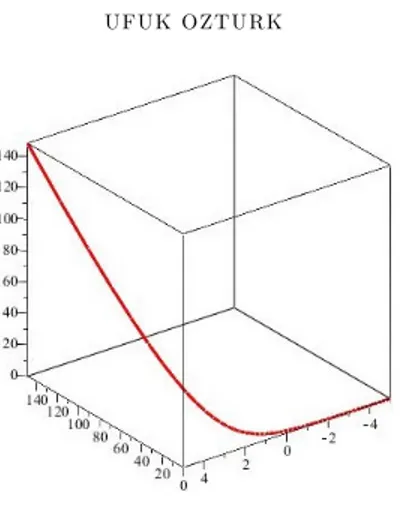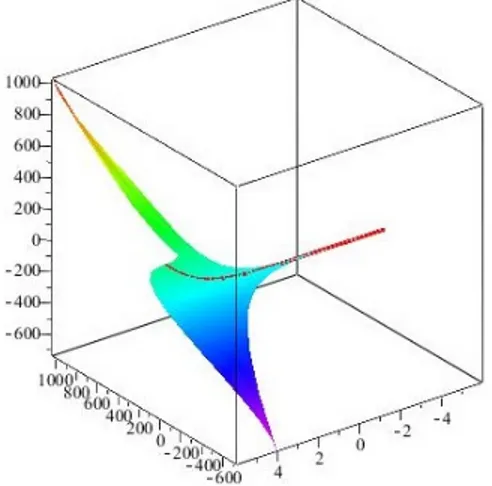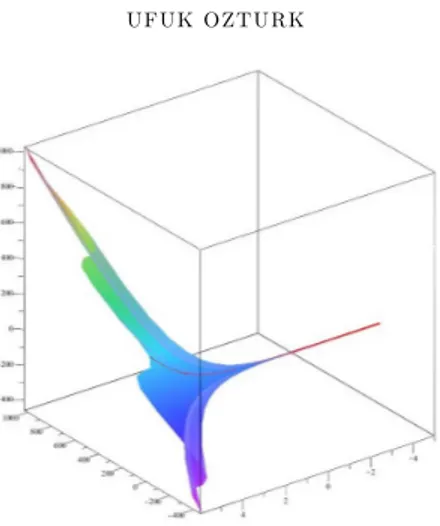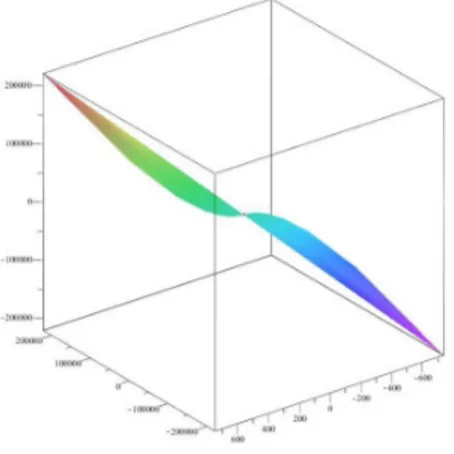D O I: 1 0 .1 5 0 1 / C o m m u a 1 _ 0 0 0 0 0 0 0 7 9 2 IS S N 1 3 0 3 –5 9 9 1
ON SURFACES WITH COMMON PSEUDO NULL GEODESIC IN MINKOWSKI 3-SPACE
UFUK OZTURK
Abstract. The problem of constructing a family of parametric surfaces from a given pseudo null curve using the Frenet trihedron frame of the curve in the Minkowski 3-space is studied. The necessary and su¢ cient conditions for the given pseudo null curve to be a common geodesic of the parametric surface are derived. As a member of the family, considered a ruled surface with a pseudo null directrix, and some corollaries on the ruled surface are given. Also, some examples are given to show the family of surfaces with a common pseudo null geodesic.
1. INTRODUCTION
At the beginning of the twentieth century, A. Einstein’s theory opened a door for use of new geometries. One of them is the geometry of special relativity, which induced on each …xed tangent space of an arbitrary Lorentzian manifold. Some of classical di¤erential geometry topics have been treated by the researchers.
In the Euclidean plane, a straight line is the shortest path between any two points. But in Euclidean 3-space, a geodesic is the shortest route between two points, so geodesics play the role of straight lines. Therefore, geodesic curves or geodesics play a crucial role in many …elds such as computer aided geometric design and robotics etc. ( see [4, 6, 9]).
In Euclidean 3-space, proposed a principle for constructing a surface pencil with a common isogeodesic curve and focused on the reverse problem by Wang, Tang, and Tai in [11]: given a space curve, how to characterize those surfaces that pos-sess this curve as a common geodesic . They also derived a su¢ cient condition on marching-scale functions for which the curve is an isogeodesic curve on a given surface with the geodesic and isoparametric constraints. In particular, it is gener-alized the work of Wang and introduced new types coe¢ cients for a given curve on the parametric surface by Kasap, Akyildiz and Orbay in [3]. In Minkowski 3-space,
Received by the editors: June 20, 2016, Accepted: November 15, 2016. 2010 Mathematics Subject Classi…cation. 53C22, 53C40.
Key words and phrases. Pseudo null curve, Geodesic curve, Parametric surface, Minkowski 3-space.
c 2 0 1 7 A n ka ra U n ive rsity C o m m u n ic a tio n s d e la Fa c u lté d e s S c ie n c e s d e l’U n ive rs ité d ’A n ka ra . S é rie s A 1 . M a th e m a t ic s a n d S t a tis t ic s .
surfaces with a common geodesic are studied and the necessary and su¢ cient con-ditions on marching-scale functions are given by Kasap and Akyildiz in [2]. Lately, the family of surfaces with a common null geodesic is studied by Safak and Kasap in [8].
In this paper, the problem on how to construct a surface family from a given pseudo null curve, which is a spacelike curve with a null principal normal, is studied in Minkowski 3-space E3
1: In Section 2, the basic de…nitions of Minkowski 3-space
E3
1 are explained that will be used throughout the paper. In Section 3, it is shown
that how to derive the necessary and su¢ cient conditions for the given pseudo null curve to be an isoparametric and a geodesic for the parametric surface. By the way, some representative curves are given to construct the corresponding surfaces which possess these curves as geodesic curves. In Section 4, when a ruled surface is considered as a member of the family, some corollaries and examples are given to illustrate for the ruled surface.
2. PRELIMINARIES The Minkowski 3-space E3
1 is the Euclidean 3-space E3 provided with the
stan-dard ‡at metric given by
g = dx21+ dx22+ dx23; (2.1)
where (x1; x2; x3) is a rectangular coordinate system of E31. Since g is an
inde…-nite metric, recall that a vector v 2 E3
1 can have one of three Lorentzian causal
characters: it can be spacelike if g(v; v) > 0 or v = 0, timelike if g(v; v) < 0 and null (lightlike) if g(v; v) = 0 and v 6= 0. In particular, the norm (length) of a vector v is given by kvk =pjg(v; v)j and two vectors ~v and ~w are said to be or-thogonal, if g(v; w) = 0. Next, recall that an arbitrary curve = (s) in E3
1, can
locally be spacelike, timelike or null (lightlike), if all of its velocity vectors 0(s) are
respectively spacelike, timelike or null (lightlike) (for more details see [5]).
If is a pseudo null curve which is a spacelike curve with a null principal normal N , the Frenet formulas have the form (see [7, 10])
2 4 T 0 N0 B0 3 5 = 2 4 00 00 0 3 5 2 4 NT B 3 5 ; (2.2) where T (s) = 0(s); N (s) = 00(s); and g(T; T ) = 1; g(N; N ) = g(B; B) = 0; g(T; N ) = g(T; B) = 0; g(N; B) = 1: (2.3)
For a pseudo null curve, the …rst curvature can take only two values: = 0 when is a straight line, or = 1 in all other cases.
The Lorentzian vector product of two vectors u = (u1; u2; u3) and v = (v1; v2; v3) in E3 1 is de…ned by u v = e1 e2 e3 u1 u2 u3 v1 v2 v3 = (u3v2 u2v3; u3v1 u1v3; u1v2 u2v1):
Lemma 1. Let u, v and w be vectors in E3
1. Then:
(i) g (u v; w) = det(u; v; w);
(ii) u (v w) = g (u; w) v + g (u; v) w;
(iii) g (u v; u v) = g (u; u) g (v; v) + g (u; v)2:
Assume that !(s) is a unit speed pseudo null curve whose Frenet frame …eld is fT (s); N(s); B(s)g in E3
1. Then, we have
T N = N; N B = T; B T = B: (2.4)
In this paper, we will assume that pseudo null base curve has the …rst curvature (s) = 1, i.e. that the curve is not a straight line.
3. SURFACES WITH A COMMON PSEUDO NULL GEODESIC CURVE IN E31
Let S be a parametric surface which is given with a pseudo null curve = (s) in the 3-dimensional Minkowski space. Then,
: [0; L] [0; T ] ! E3 1
(s; t) ! (s; t) = (s) + e(s; t); (3.1)
where a(s; t); b(s; t) and c(s; t) are C1 functions and e is given by
e(s; t) = a(s; t)T (s) + b(s; t)N (s) + c(s; t)B(s): (3.2) If the parameter t is seen as the time, then the functions a(s; t); b(s; t) and c(s; t) can be viewed as directed marching distances of a point unit in the time t in the direction T; N and B, respectively, and the position vector is seen as the initial location of this point.
By taking the derivative of the equation (3.2) with respect to s and using the Frenet equations (2.2), we get
es =
@e @s
= (as c) T + (bs+ b + a) N + (cs c ) B: (3.3)
The normal (s; t) of the surface S is given by (s; t) = s t;
and since s= @ @s = (as c + 1) T + (bs+ b + a) N + (cs c ) B; and t= @ @t = atT + btN + ctB; using the equations (2.4), the normal vector can be written as
(s; t) = ((bs+ b + a) ct (cs c ) bt) T
+ ((as c + 1) bt (bs+ b + a) at) N
+ ((cs c ) at (as c + 1) ct) B:
(3.4) Let the curve = (s) on the surface S, given by equation (3.1), be an isopara-metric. Then, there should exist a parameter t = t0 such that (s) = (s; t0)
where
a(s; t0) = b(s; t0) = c(s; t0) = 0; (3.5)
and from (3.4) we obtain
(s; t0) = (bsct csbt) T + ((as+ 1) bt bsat) N + (csat (as+ 1) ct) B:
According to the geodesic theory in [1], the curve on the surface S is a geodesic if only if the principal normal N (s) of the curve and the normal (s; t0) of the
surface S at any point on the curve are parallel to each other. Thus, for all s 2 [0; L] N (s) k (s; t0) if and only if bsct csbt= 0; (as+ 1) bt bsat6= 0; csat (as+ 1) ct= 0: (3.6) Therefore, we can give the necessary and su¢ cient conditions for the surface S to have the pseudo null curve as an isoparametric and a geodesic with the following theorem.
Theorem 1. Let S be a parametric surface given by (3.1) in Minkowski 3-space. The curve is an isoparametric and a geodesic curve on the surface S if and only if the following conditions are satis…ed
a(s; t0) = b(s; t0) = c(s; t0) = 0;
bsct csbt= 0;
(as+ 1) bt bsat6= 0;
csat (as+ 1) ct= 0;
We call the set of surfaces de…ned by the equations (3.1), (3.5) and (3.6) a family of surfaces with a common pseudo null geodesic, where the common pseudo null geodesic is both an isoparametric and a geodesic curve on these surfaces. Any surface S is de…ned by the equation (3.1) and satisfying for the equations (3.5) and (3.6) is a member of the family.
As mentioned in [11], the marching-scale functions a(s; t); b(s; t) and c(s; t) can be decomposed into two factors:
Case 1. If we choose
a(s; t) = l(s)A(t); b(s; t) = m(s)B(t);
c(s; t) = n(s)C(t);
(3.7) where l(s), m(s), n(s), A(t), B(t) and C(t) are C1 functions, and l(s), m(s) and n(s) are not identically zero. Then, from Theorem 1 we can simply express the nec-essary and su¢ cient conditions for the pseudo null curve being an isoparametric and geodesic curve on the surface S as follows
8 < : A(t0) = B(t0) = C(t0) = 0; dB(t0) dt = const 6= 0; m(s) 6= 0; dC(t0) dt = 0; or n(s) = 0; (3.8)
When the marching-scale functions a(s; t); b(s; t) and c(s; t) depend only on the parameter t, if we choose l(s) = m(s) = n(s) = 1, then the corresponding family of surfaces with a common pseudo null geodesic becomes
(s; t) = (s) + A(t)T (s) + B(t)N (s) + C(t)B(s): By simplifying, condition (3.8) can be represented as
A(t0) = B(t0) = C(t0) = 0; dB(t0) dt = const 6= 0; dC(t0) dt = 0: Case 2. If we choose a(s; t) = f (l(s)A(t)); b(s; t) = g(m(s)B(t)); c(s; t) = h(n(s)C(t));
where l(s), m(s), n(s), A(t), B(t), C(t), f , g, and h are C1 functions. Then, from
Theorem 1 and (3.8) we can simply express the necessary and su¢ cient conditions for the pseudo null curve being an isoparametric and geodesic curve on the surface S as follows 8 > > < > > : A(t0) = B(t0) = C(t0) = 0; f (0) = g(0) = h(0) = 0; dB(t0) dt = const 6= 0; m(s) 6= 0; g0(0) 6= 0; dC(t0) dt = 0; or n(s) = 0; or h0(0) = 0; (3.9)
Figure 1. The curve
The choices above give an advantage: any set of functions l(s), m(s), and n(s) would satisfy (3.8) or (3.9). Thus we can select di¤erent sets of functions l(s), m(s), and n(s) to adjust the shape of the surface until they are grati…ed with the design, and the resulting surface is guaranteed to belong to the surface family with the pseudo null curve (s) as the common geodesic.
Example 1. Let S be a parametric surface given by (3.1) in Minkowski 3-space. Let us consider the pseudo null helix with parameter equation (see Fig. 1)
(s) = (sinh s + cosh s; s; sinh s + cosh s): Then we get the Frenet vectors as follows:
!
T (s) = 0(s) = (sinh s + cosh s; 1; sinh s + cosh s); !
N (s) = 00(s) = (sinh s + cosh s; 0; sinh s + cosh s); !
B (s) = ( (sinh s+cosh s)2(sinh s+cosh s)2+1; 1;1 (sinh s+cosh s)2(sinh s+cosh s)2): Moreover, the curvatures and of have the form
(s) = 1 and (s) = 1: If we choose
a(s; t) = sin t; b(s; t) = t;
c(s; t) = 0;
where ; 2 R and 6= 0. Then, the surface family with the common pseudo null geodesic is given by
(s; t) = (cosh s + sinh s) ( sin t + t + 1) ; sin t + s; (cosh s + sinh s) ( sin t + t + 1) :
Figure 2. A member of surface family for = 1, = 1 and the curve
For = 1 and = 1 we obtain a member of the surface (see Fig. 2) as (s; t) = (cosh s + sinh s) (sin t t + 1) ; sin t + s;
(cosh s + sinh s) (sin t t + 1) ; where t 2 [ 5; 5].
For = sin t and = 1 we obtain a member of the surface (see Fig. 3) as (s; t) = (cosh s + sinh s) sin
2
t + t + 1 ; sin2t + s; (cosh s + sinh s) sin2t + t + 1 ; where t 2 [ 5; 5].
4. RULED SURFACE WITH A COMMON PSEUDO NULL GEODESIC CURVE
For a member of the family is de…ned by (3.1), consider a ruled surface (s; t) with a pseudo null directrix (s) which is also an isoparametric. In that case, there exists a parameter t = t0 such that (s; t0) = (s). Then, for s 2 [0; L] and
t0; t 2 [0; T ] the surface (s; t) can be expressed as
(s; t) (s; t0) = (t t0) D(s);
where D(s) denotes the direction of the rulings. Also, from the equations (3.1) and (3.2), we get
Figure 3. A member of surface family for = sin t, = 1 and the curve
Using the equations (2.3) and (2.4), a system of three equations with three unknown functions a(s; t), b(s; t) and c(s; t) can be written as
a(s; t) = (t t0) det [D(s); N (s); B(s)] ;
b(s; t) = (t t0) det [D(s); B(s); T (s)] ;
c(s; t) = (t t0) det [D(s); T (s); N (s)] :
(4.1) The above equations in (4.1) are just the necessary and su¢ cient conditions for a ruled surface (s; t) to have a pseudo null directrix (s) as an isoparametric. If the curve (s) is also a geodesic on the surface (s; t) by using the conditions given in (3.8), then we get
det [D(s); B(s); T (s)] 6= 0;
det [D(s); T (s); N (s)] = 0: (4.2)
It follows that at any point on the curve (s); the ruling direction D(s) must be in the plane spanned by T (s) and N (s). Moreover, the ruling direction D(s) and the vector T (s) must not be parallel. Thus, for some real functions u(s) and v(s), we can write
D(s) = u(s)T (s) + v(s)N (s); (4.3)
where v(s) 6= 0 for all s 2 [0; L]. Substituting it in (4.1)-(4.3), we have a(s; t) = tu(s);
b(s; t) = tv(s); c(s; t) = 0;
(4.4) where b(s; t) 6= 0 for all s 2 [0; L].
Thus, the ruled surface with the common pseudo null geodesic directrix (s) is given by
where the real functions u(s) and v(s) control the shape of the ruled surface, and v(s) 6= 0 for all s 2 [0; L]. On the other hand, there exist two geodesic curves passing through every point on the curve (s): one is (s) itself and the other is a straight line in the direction D(s) as given in (4.3). Every member of the ruled surface with the common pseudo null geodesic directrix can be expressed by the direction vector function D(s).
Case 3. If the ruled surface, which is given by (4.5), is a cylindrical surface, then we can write
D (s) D0(s) = 0; (4.6)
for all s 2 [0; L]. So, there exists a function (s) such that
D0(s) = (s) D (s) ; (4.7)
for all s 2 [0; L]. From (2.2) and (4.3) we get the system as follows:
u0(s) = (s) u(s); (4.8)
and
v0(s) + u(s) + v(s) (s) = (s) v(s): (4.9)
The general solution of (4.8) is given by u(s) = C1e
R
(s)ds; (4.10)
where C1 is a constant of integration. From (4.9) and (4.10), we obtain
v(s) = C2+ C1
Z
eR (s)dsds eR( (s) (s))ds; (4.11)
where C1 and C2 are constants of integration.
If (s) = 0 for all s 2 [0; L], then the last equation becomes v(s) = (C1s + C2) e
R
(s)ds: (4.12)
Therefore, we can give the following corollary.
Corollary 1. Let the ruled surface, which is given by (4.5), be a cylindrical surface. If the ruled surface has two of the following properties, it has the third also, (i) The base curve is a planar curve,
(ii) The base curve is both a geodesic and an isoparametric, (iii) The real functions u(s) and v(s) are given by
u(s) = C1e R (s)ds; v(s) = (C1s + C2) e R (s)ds;
Case 4. If the ruled surface, which is given by (4.5), is a non-cylindrical surface, then we can write
D (s) D0(s) 6= 0; (4.13)
for all s 2 [0; L]. Also, from (2.2)-(2.4) and (4.3) we have
g(D (s) D0(s) ; 0(s)) = det [D (s) ; D0(s) ; 0(s)] = 0; (4.14) for all s 2 [0; L].
Thus, we can give the following corollary.
Corollary 2. If the ruled surface, which is given by (4.5), is a non-cylindrical surface, then the ruled surface is always a developable surface for all s 2 [0; L] and t 2 [0; T ].
Example 2. Let S be a ruled surface whose geodesic curve is the pseudo null helix in Example 1, with C1= 1, C2= 1 and (s) = 1 for all s.
If the controlling functions of the ruled surface for all s are u(s) = es and v(s) =
1 + es, then the corresponding cylindrical surface is drawn as in Figure 4.
Figure 4. The ruled surface with pseudo null helix
If the controlling functions of the ruled surface for all s are u(s) = cos s and v(s) = e s, then the corresponding non-cylindrical surface is shown in Figure 5.
Example 3. Let S be a ruled surface with a pseudo null directrix in E3
1. Let us
consider the pseudo null helix with parameter equation (see Fig. 6) (s) = s
2
2 ; s2
Figure 5. The ruled surface with pseudo null helix
Figure 6. The curve
Then we get the Frenet vectors as follows
!T (s) = 0(s) = (s; s; 1) ; !N (s) = 00(s) = (1; 1; 0) ; !B (s) = (1+s2 2 ; s2 1 2 ; s): (4.16)
Moreover, the curvatures and of have the form
If the controlling functions of the ruled surface for C1 = 1, C2 = 1 and (s) = 0
for all s are
u(s) = 1;
v(s) = 1 + s; (4.18)
then the corresponding cylindrical surface is drawn as in Figure 7.
Figure 7. The curve
References
[1] N. H. Abdel-All, R. A. Abdel-Baky, F. M. Hamdoon, "Ruled surfaces with timelike rulings " Applied Mathematics and Computation 147 (2004), no. 1, 241–253.
[2] E. Kasap, F. T. Akyildiz, "Surfaces with common geodesic in Minkowski 3-space " Applied Mathematics and Computation 177 (2006), no. 1, 260–270.
[3] E. Kasap, F. T. Akyildiz, K. Orbay, "A generalization of surfaces family with common spatial geodesic" Applied Mathematics and Computation 201 (2008), no. 1-2, 781–789.
[4] G. V. V. R. Kumar, P. Srinivasan, V. D. Holla, K. G. Shastry, B. G. Prakash, "Geodesic curve computations on surface " Computer Aided Geometric Design 20 (2003), no. 2, 119–133. [5] B. O’Neill, "Semi-Riemannian geometry: With applications to relativity " Academic Press
Inc., New York 1983.
[6] M. Paluszny, "Cubic polynomial patches through geodesics " Computer Aided Design 40(2008), no. 1, 56–61.
[7] M. Petrovi´c-Torgašev, E. Šu´curovi´c, "Some characterizations of the spacelike, the timelike and the null curves on the pseudohyperbolic space H2
0 in E13" Kragujevac Journal of
Mathe-matics 22 (2000), 71–82.
[8] G. Sa¤ak, E. Kasap, "Family of surface with a common null geodesic" International Journal of Physical Sciences 4 (2009), no. 8, 428–433.
[9] J. Snchez-Reyes, R. Dorado, "Constrained design of polynomial surfaces from geodesic curves " Computer Aided Design 40 (2008), no. 1, 49–55.
[10] J. Walrave, "Curves and surfaces in Minkowski space " Thesis (Ph.D.), Katholieke Univer-siteit Leuven, Belgium 1995.
[11] G. J. Wang, K. Tang, C. L. Tai, "Parametric representation of a surface pencil with a common spatial geodesic" Computer Aided Design 36 (2004), no. 5, 447–459.
Current address : Department of Mathematics, Çank¬r¬ Karatekin University, Çank¬r¬, 18100, Turkey





